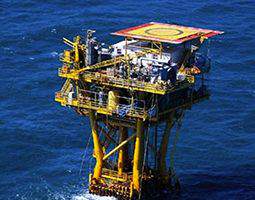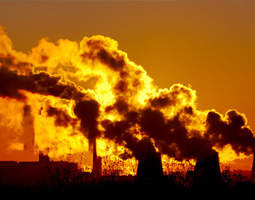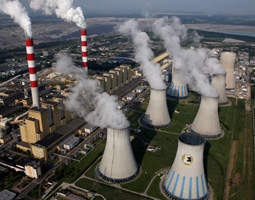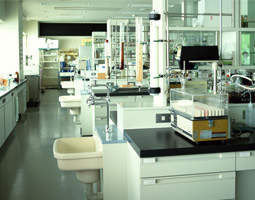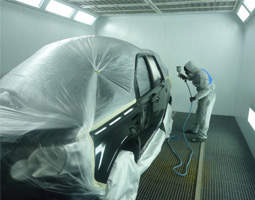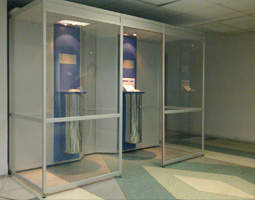INLET AIR FILTER HOUSE FOR GAS TURBINES. ANALYSIS AND OPTIMIZATION WAYS.
Dr. Oleg Provolovich,
“NPP “ FOLTER ”, Limited Liability Company, Russia, Moscow
folter@folter.ru
The last twenty years in Russia, the rapid growth in the use of gas turbines (GT) occurs in the energy sector, where the issue of increasing the capacity of electricity supply is solved with the help of them in a relatively short time.
Large industrial enterprises are following a similar path, thus closing the need for energy capacities and at the same time reducing their risks from the rise in tariffs of electricity purchased on the market.
The traditional and multi-year consumer of GT is Gazprom PJSC, which provides transportation of natural gas throughout the country, as well as large-scale gas supplies to foreign consumers.
The basis of Gazprom’s Unified Gas Pipeline System is gas pumping stations, where gas is transported using gas turbines of various capacities. And along with domestic gas turbines, gas turbines of foreign manufacturers, such as Siemens and GE Energies, are used in projects.
GTs are consumers of a large amount of atmospheric air, which is necessary for the gas combustion process in GTs. So, operation of a gas turbine with a capacity of 25 MW requires about 260 thous. m³/h of air, and for the most powerful GT (about 400 MW), the air demand is 2.5 MIO m³/h.
Atmospheric air always contains some amount of dust particles of natural origin associated with soil erosion, generation of various dusts, and plants (fluff of poplars, dandelions, pollen, etc.). Additional air pollution is caused by technogenic factors associated with human activity (vehicle exhaust, ventilation emissions from industrial enterprises, etc.). This leads the air containing dust particles gets to moving and rotating elements of gas turbine and compressor units. Abrasive wear is especially inherent to gas turbine blades; it leads to a decrease in the efficiency of the entire gas turbine.
Contamination of gas turbine components leads to additional costs associated with disassembling and cleaning these components.
For the above reasons, the need arises for highly efficient cleaning of cycle air in gas turbines.
To solve this problem, special Intel Air Filter House (FH) are used. FHs are, as a rule, a stand-alone structure connected by an air duct to a gas turbine unit. As a rule, air intake into FH is carried out at a height of at least 8-10 meters. Components that protect FH from the effects of direct precipitation (rain and snow) with the help of special weather hoods, drip tray, etc. are located at the intake of FH.
As noted above, the FH task is to perform highly efficient cleaning of large volumes of air with the help of various filter elements, whose performance ranges from 2 to 5 thous. m³/h.
In this regard, FH are large metal structures with a weight of several tons to several hundred tons.
Therefore, the FH developers are faced with the task of creating filtering systems that are the basis of FH, allowing to reduce the size and weight of FH.
At present, GTs of all well-known energy companies, such as GE Energy, Siemens, Alstom, Ansaldo, Mitsubishi and others, with a capacity of 30 to 400 MW, as well as GTs from Russia with a capacity of 6 to 110 MW installed in Russia.
In the proposed analysis, gas turbines with a capacity of more than 30 MW will be considered.
FH filtration systems are divided into two types.
- 1st: multistage system with static type filters;
- 2nd: with self-cleaning pulse filters, which in most cases work as static filters, and their total share is 3-5% of all Russian FHs.
Given the above, all further analysis will be devoted to FH with static filters.
The third version of the combined filtration system in FH : a - reversible pocket type CF, class G4, filtration area of 2.5–3.5 m2, the service life of six months; b - FF, class F8 – F9, service life of 1.5–2 years
The system with static type filters is a two-, three- or four-stage filtration system, in which, as a rule, at the inlet of FH, coalescing filters are installed, after which air purification is provided with 2 or 3 filter stages with finishing filters of classes F8 or F9. It should be noted that in recent years more effective filters of classes E10-E12 are beginning to be used as finishing filters.
Filters that are installed in front of the finishing filters protect the finishing stage against coarse dust, increasing its service life.
All filters: coalescing filters, coarse filters (CF), fine filters (FF) and EPA filters are installed in metal panels of cellular construction, which are placed step by step in the FH design. The total number of filters of each stage in FHs of different capacities ranges between 100 and 600, which requires significant volumes for their placement and leads to the creation of FHs with a large weight.
A single FH filter element, as a rule, has overall dimensions at the inlet cross-section of 592x592 mm and capacity of 3,000 to 5,000 m³/h.
The above described shows that high-flow and compact filtering systems must be used to reduce the size and weight of FH.
To reduce FH dimensions, a combination of two or three stages on the same panel to install filters is used.

Fig. 1. The first version of the combined filtration system in FH:
a - coarse filter (CF), class G4, filtration area is 2–2.5 m2, the service life of six months;
b - fine filter (FF), class F8 – F9, service life about 1 year

Fig. 2. The second version of the combined filtration system in FH:
a - pocket type CF, class G4, filtration area of 2.5 m2, the service life of six months;
b – CF housing;
c - FF, class F8 – F9, service life about 1 year;
g - filtration system in operating position.

Fig. 3. The third version of the combined filtration system in FH:
a - reversible pocket type CF, class G4, filtration area of 2.5–3.5 m2, the service life of six months;
b - FF, class F8 – F9, service life of 1.5–2 years

Fig. 4. The fourth version of the combined filtering system in FH®:
a – Reverse CF, class G4, filtration area of 5–14 m2, the service life of 1–3 years;
b - FF, class F8 – F9, filtration area jf 20–45 m2, the service life of 1–3 years;
c - filtration system in operating position

Fig. 5. The fifth version of the combined filtering system in FH®:
a - coalescing filter (COF), class G2, regenerated by washing with water;
b - reverse CF, class G4, filtration area of 5–14 m2, the service life of 1–3 years;
c - FF, class F8 – F9, filtration area 20–45 m2, the service life of 1–3 years;
g - filtration system in operating position
Fig. 1 - Fig. 5 show five versions of combined filtering systems in FH currently used.
4 and 5 versions from the above developed by NPP Folter are distinguished by a higher resource and lower pressure drop to the use of coarse filters with a large filtering surface, which allows to increase the service life of filters and reduce operating costs when operating the GT.
Analyzing all FH operated with GTs and with static type filters, they can be divided into two groups.
The first type of FH contains a filtration system located perpendicular to the direction of the air flow (Fig. 6). Simens, Ansaldo, Alstom, Mitsubishi and others equip their GTs use it.

Fig. 6. Frontal installation of filters

Fig. 7. FH with one- (a) and three-way (b) air inlet
This design are produced with one-way or three-way air inlet (Fig. 7).
In the second type of FH, the filtration system is installed as a W-shaped system, where the air filters are installed at an angle to the direction of air flow (Fig. 8).
Such an FH design was developed by AAF (USA) and is used by GE Energy to equip its GTs.
The FH of the described design (Fig. 8) is operated in Russia at the Vologda Power Plant (PP), Syzranskaya PP, Novomoskovskaya PP and others, and they use the combined layout of coarse and fine filters in accordance with version 1 as a filtration system (Fig. 1).

Fig. 8. FH with W-shaped filtration system and the first version of the FF and CF placement (Fig. 1).

Fig. 9. FH with W-shaped filtration system and the third version of the FF and CF placement (Fig. 3).
In the past few years, GE Energy has begun to use combined coarse and fine filters in version 3 (Fig. 3) (Kazanskaya PP-2 and PP-3 (Fig. 9)) in the W-shaped system.
To compare different FH design solutions with each other, the author proposes to introduce an indicator of specific weight, that is, the ratio of FH weight without air channel from FH to GT to the nominal volume of air flow.

Mu – specific weight;
M – FH weight (g);
Q – nominal volume of air flow (m³/h).
Table 1 shows the indicators of the specific weight of the three main structural types of FH and the relative decrease in the weight compared with the worst one for Mu.
| Item No. | FH type | MU, g/m³/h | Decrease in weight relative to FH according to C.1, % |
| 1. | Three way air inlet (GT-160MW) | 79 | - |
| 2. | One-way air inlet (GT 160MW) | 70 | 11 |
| 3. | One way air inlet with AAF W-shaped system (GT 77-400 MW) | 55-65 | 25-30 |
When comparing the above data, it can be seen that with a “frontal” installation of the FH filtration system with a one-way air intake, it is lighter than a three-way FH by 11%, and the FH with the W-shaped system is 25-30% lighter.
As is well known, the reduction in weight of FH reduces its cost, which allows to significantly reduce investment expenditures during the construction of a gas turbine unit.
The analysis also showed that the air velocity in FH with a “frontal” installation of filtration systems is about 2 m/s, and with the W-shaped system is about 4 m/s, which allows to conclude that it is necessary to develop FH with the maximum possible air velocity in the living FH cross section to filtration systems when all the basic technical requirements (pressure drop, efficiency filter) are fulfilled.
Based on the above analysis of FH structures, theoretical studies of various possible design solutions for FH were carried out in order to develop new types of FH, reducing their weight and, accordingly, cost.
In carrying out the proposed studies, 3D modeling of various structural solutions for FH and mathematical modeling of aerodynamic air flows were performed using the ANSYS software for computational fluid dynamics, which made it possible to visualize and realize flow lines, air velocity fields, total and static pressures.
As a basis for the calculations, a more efficient combined filtering system was adopted according to version 4 (Fig. 4), according to which there were data on three standard sizes obtained in the course of previously conducted tests on certified test rig. Fig. 10, 11 and 12 show schemes of three sizes of the combined filtering system according to version 4 (Fig. 4).

Fig. 10. Standard filtering system Folter® with the fourth version of CF and FF placement:
a - CF (G4) + FF (F8 – F9);
b - filtration system in operating position, capacity of 3400–4250 m3/h

Fig. 11. High-flow filtration system Folter® according to the fourth version of the CF and FF placement:
a - CF (G4) + FF (F8 – F9);
b - filtration system in the operating position.
The capacity of 4250–4500 m3/h is increased by 20%, the service life is increased by 1.5 times

Fig. 12. Super-flow filtration system Folter® according to the fourth version of the CF and FF placement:
a - CF (G4) + FF (F8 – F9);
b - filtration system in operating position.
Capacity of 5000–5200 m3/h is increased by 30%, service life is increased by 2–3 times
As a first study option, the proposed Parallel Air Filtration System® in FH for GT 110MB was considered. A schematic diagram of this type of FH is shown in Fig. 13.
In this constructive solution, coalescing filters are arranged in the form of a W-shaped system to increase speed in the living section of FH (Fig. 13).
As coarse filters (CF) class G4 and fine filters (FF) class F9, their combined installation according to version 4 (Fig. 4) with overall dimensions of CF + FF = 400 + 400 mm (Fig. 11) was adopted.
CF and FF filters were located in two parallel rows in the direction of air flow. The first row of filters along the air flow had channels at the edges of FH for passage of part of the cycle air to the second row of the CFs and FFs, and the second row had a channel in the middle for the exit of air treated in the first row (Fig. 13).

Fig. 13. Diagram of FH with Parallel Filtering System®
For mathematical modeling, a coarse and fine filtering system of 400+400 mm (Fig. 11) with a capacity of 4170 m³/h (240 set) was considered.
The modeling was performed at different air velocities in the living section of FH. Fig. 14 shows the static pressure for a Parallel Filtration System at a velocity of 4 m/s in FH, which corresponded to the nominal air flow rate for a gas turbine of 110 MW (1020 thous. m³/h).
Studies have also shown that a further increase in air velocity in FH leads to a sharp increase in the pressure drop of the entire structure.
In order to compare parallel and W-shaped systems with each other, similar mathematical modeling was performed using the example of FH of Kazanskaya PP-2.
The modeling results for these two systems are shown in Fig. 14.

Fig. 14:
a – static pressure drop for W-shaped filtration system at air velocity of 4.3 m/s;
b - static pressure drop for Parallel Filtration System at air velocity of 4.1 m/s
Calculations showed that the pressure drop of both two-type systems at an air velocity in the living section of about 4 m/s was about 420 Pa.
The analysis also showed that the W-shaped and parallel systems are also comparable in overall dimensions, which allows to conclude that the parallel filtering system can be used as an alternative to the W-shaped system. The Parallel Filtration System due to the high velocity in the living section (4 m/s) has a low weight FH, as well as the W-shaped system. However, it is easier to manufacture.
Further analysis of numerous FH projects in Russia at operating GTs revealed a peculiarity that, as a rule, FH is always located at some distance from the GT and requires an additional, in some cases long, air channel to connect the output confuser (plenum) of FH with the inlet flange of the gas turbine compressor.

Fig. 15. Overall schemes of inlet air Filter House (FH) with the air channel for some existing projects of FH in Russia.
a – FH for 110MW GT of Ivanovo PP.
b – FH for 180MW GT of Kirov PP-3.
c – FH for 160MW GT of Izhevsk PP-1.
g – FH for 160MW GT of PP-21 (Moscow).
Fig. 15 shows some FH schemes with air channels for a number of operating GT (Ivanovskaya PP, 110MW GT; Kirov PP-3, 180MW GT; Izhevskaya PP-1, 160MW GT; Moscow PP-21, 160MW GT).
From the above schemes, it can be seen that the length of air channel from FH to GT is 25m for the Ivanovo PP, 19m for the Izhevskaya PP-1, 30m for the Moscow PP-21 and Kirovskaya PP-3.
In all the above projects, these air channel have a large living section in order to place a silencer in them closer to the GT.
The air velocity in these air channels is 7-8 m/s.
In most cases, the weight of these air channels is comparable to the weight of FH.
Based on the above analysis, the possibility of placing components of FH in the channel was proposed for consideration.
The initial analysis was carried out on the example of the existing project GT-SGT5-2000E with a Siemens turbine with a capacity of 180MW (Kirov PP-3).
The design of the FH with the wedge placement of the filtration system, called the “Channel Filter House®”, was adopted as a computational model, the scheme of which is shown in Fig. 16.
.jpg)
.jpg)
Fig. 16. Scheme of Channel FH for a 180MW GT
As can be seen from fig. 16, Channel FH includes: weather hoods, anti-icing system, coalescing filters and coarse (G4) and fine (F9) filters, arranged according to the fourth version (Fig. 4 and Fig. 12), with overall dimensions of 600÷600 mm. At the air outlet of the filtration system, there is a silencer.
The total number of coarse and fine filters (G4+F9) was 368 set placed in 2 floors, with 4 tiers per floor.
The nominal capacity of the CF+FF filter set was 4300 m³/h.
Due to the peculiarities of the considered filtering system for coarse and fine purification, namely, the large filtering surface of CF G4 (15 m²) and FF F9 (45 m²), the service life of this system will be at least 2-2.5 years.
The overall dimensions of the Channel FH in the living section were taken close to the dimensions of the channel of the existing project (5.5 x 11 m).
The length of the channel FH without weather hoods was about 20m, which corresponds to the length of the air channels of the above projects.
For the channel FH scheme shown in Fig. 16, mathematical modeling was performed, the results of which are shown in Fig. 17.
The total air flow rate was adopted in the amount of 1,587 thous. m³/h corresponding to an air flow rate for a 180MW GT.

Fig. 17. Mathematical modeling of the filtration system aerodynamics in the channel FH of 180MW GT:
a – total pressure drop, Pa;
b - air flow velocity, m/s
The pressure drop of the two-stage filtration system was 380 Pa, and the total pressure drop of FH, including the silencer, up to the GT inlet is 750-800 Pa, which meets the requirements for the 180MW GT.
If it is necessary to solve the problem of reducing the pressure drop of Channel FH, it can be achieved by increasing the number of filters with a slight increase in the length of Channel FH.
To estimate the weight of the considered Channel FH for a gas turbine of 180 MW, 3D modeling was performed (Fig. 18), which shows that the weight of Channel FH is 40% less than the existing FH together with the air channel.
Similar calculations and modeling were performed for the 110MW GT based on the real project (Ivanovskaya PP) and the Technical Assignment for FH of 32MW GT.

Fig. 18. Comparison of two versions of FH for the 180MW GT:
a – weight of FH and the air duct without filters and the silencer for the 180MW GT (Kirov PP-3) ≈ 190 tons;
b – the weight of the channel FH for the 180MW GT without filters and the silencer ≈ 115 tons
Fig. 19 shows a scheme of Channel FH for a 110MW GT with a wedge filtering system of CF+FF (400+400 mm) according to version 5 (Fig. 5), that is, a three-stage system. At the same time, the capacity of a single module was 4050 m³/h. A total of 252 set, 2 floors, 4 and 3 tiers on the first and second floors, respectively. The total length of the Channel FH was about 15m.
Mathematical modeling of Channel FH has shown that with a nominal capacity of 1020 thous. m³/h, the pressure drop of the three-stage system will be about 500 Pa, and the total pressure drop will not exceed 850 Pa.
It should be noted that in this calculation the size of the channel was chosen based on the features of the Ivanovskaya PP project, where the air channel passes between two columns with a restriction of this size. If these restrictions are removed and the filtration system is rearranged, the pressure drop of the filtration system can be reduced.
3D modeling of Channel FH for 110 MW GT is shown in Fig. 20 in comparison with the existing project and it is clear from it that the weight of the Channel FH is more than two times lighter than the existing FH and is able to fit along the length of the existing air channel.
.jpg)
.jpg)
Fig. 19. Scheme of Channel FH for 110MW GT

Fig. 20. Comparison of two FH constructions for 110MW GT (Ivanovskaya PP):
a) - weight of FH with an air channel without a silencer and filters ≈ 80 tons;
b) - weight Channel FH without a silencer and filters ≈ 34 t
Further studies of the applicability of Channel FH for 32 MW GT were performed on the basis of the technical assignment, for which sketch drawings of standard FH from the technical assignment and Channel FH were performed.
A scheme of a standard FH according to the technical assignment is shown in Fig. 21, and from the scheme it can be seen that the air from the upper channel of FH is sent for combustion to the GT, and from the lower part – for the ventilation of the GT. According to the technical assignment for air flow in the gas turbine, a three-stage filtering system per version 5 (Fig. 5) with overall dimensions of the CF+FF (292+292 mm) in the amount of 96 set (3200 m³/h/set) was accepted for consideration. And for ventilation, a two-stage scheme with a coalescing filter G2 and a reversible filter CF G4 (292 mm) - 32 set (2700 m³/h/set) was accepted.
.jpg)
.jpg)
Fig. 21. Scheme of standard FH for 32MW GT
Fig. 22 shows the scheme of Channel FH® with similar filters in the same quantity.
The overall dimensions of the Channel FH for the combustion process of a gas turbine were 2.7 x 4.4 m in the living section, and the length without weather hoods was 9.5 m, which allows it to be located within the projected building.
Mathematical modeling showed that the pressure drop of the three-stage combined filtering system of Channel FH for the combustion process of a gas turbine was 360 Pa at a nominal flow rate of a gas turbine of 307,200 m³/h, and the total pressure drop of FH was about 600 Pa, which meets the requirements for 32 MW GT.
.jpg)
.jpg)
Fig. 22. Channel FH scheme for 32MW GT
To compare the two versions, 3D modeling of FH according to the technical assignment and Channel FH was performed, the results of which are shown in Fig. 23. A comparison shows that Channel FH is 48% lighter than standard FH.

Fig. 23. Comparison of two FH constructions for 32MW GT:
a - weight of standard FH without filters ≈ 35,000 kg;
b - weight of the channel FH without filters ≈ 18,500 kg
The analysis and theoretical studies have shown that in cases where FH is located at some distance from the GT inlet, it is advisable to use Channel FH®, which can reduce the weight and, accordingly, the cost of FH, which can be up to 40-50%.
Reducing the weight of FH in some cases also leads to a reduction in the cost of construction and installation work associated with the manufacture of FH foundations located outside.
The analysis of the design features of the FH for the GTs operating in Russia allows us to draw the following conclusions.
1. FH of GT are designed to treat large volumes of air, in connection with which their design is a large-sized and metal-intensive products.
2. The use of standard fine filters in one unit with return (reversible) coarse filters with increased filtering area reduces the pressure drop and extends the service life of both stages in existing FH of GT, and also allow to develop new designs of FH with reduced weight.
3. An analysis of all operating FH in Russia showed that FH with a W-shaped arrangement of the filtering system of CF and FF have the lowest specific weight.
4. A new Parallel Filtering System® FH was proposed, which in terms of weight is not inferior to the W-shaped filtration system, and theoretical calculations and mathematical modeling showed its practical applicability.
5. Analysis of existing FH of GT showed that in many cases FH is located at some distance from the GT and requires the use of an additional air channel to connect the output confuser (plenum) of FH to the input of the GT compressor. This leads to a rise in the cost of FH and the cost of its construction.
6. A new design of Channel FH® was proposed, which allows to reduce the weight and, accordingly, the cost by 40-50% compared to the current FH projects.
7. The reduction of the weight of the Channel FH can also lead to a decrease in the construction and installation work on the GT.
8. Theoretical calculations and mathematical modelling have shown the applicability of Channel FH® for existing projects of FH of GT 32, 110 and 180 MW.
9. Mathematical modeling of different versions of Channel FH showed that by varying the channel section sizes (width, height), as well as using various combined filtering systems of CF and FF from 292+292 mm to 600+600 mm, it is possible to achieve a given pressure drop of the entire FH.
10. It is advisable to continue studies of new constructive solutions of FH at GT of other capacities for specific projects.
11. The author invites all interested to cooperation.
